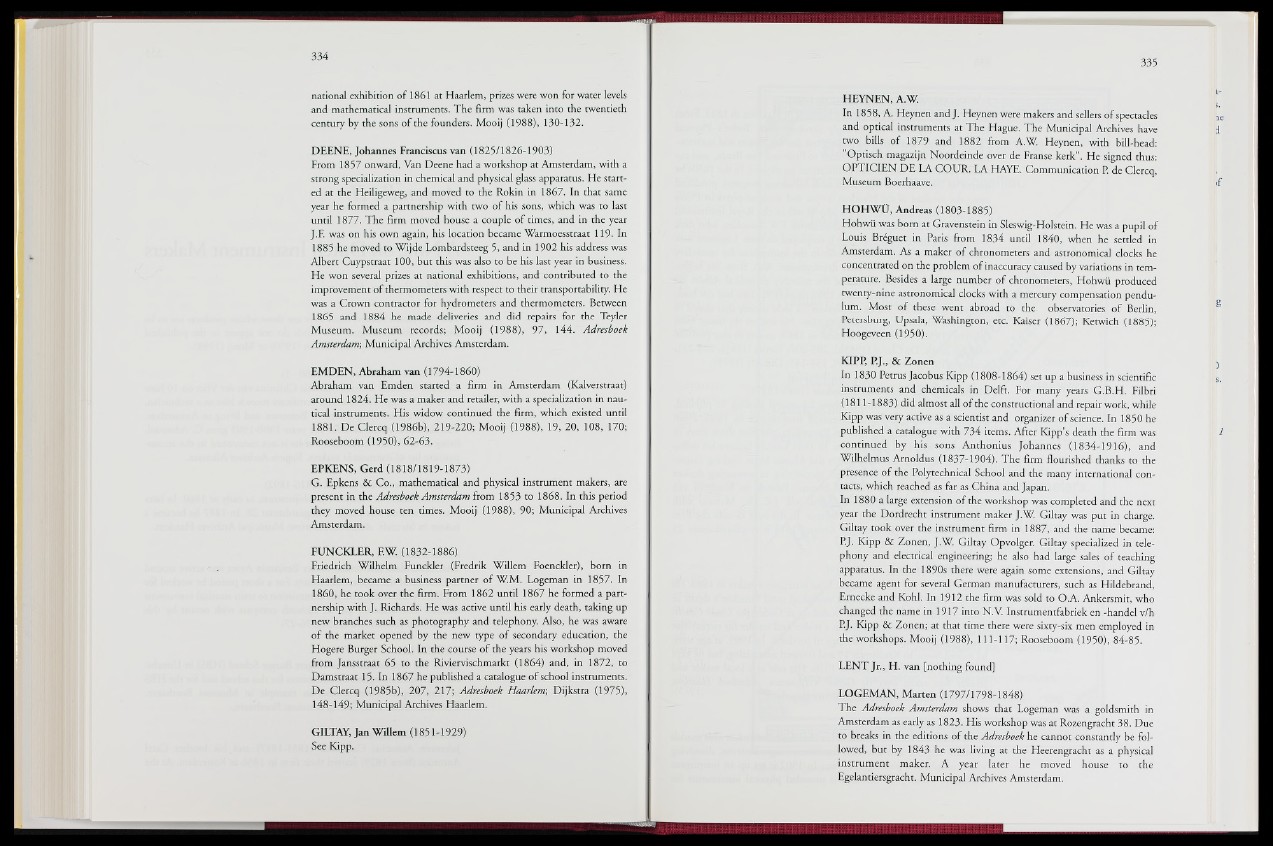
national exhibition of 1861 at Haarlem, prizes were won for water levels
and mathematical instruments. The firm was taken into the twentieth
century by the sons of the founders. Mooij (1988), 130-132.
DEENE, Johannes Franciscus van (1825/1826-1903)
From 1857 onward, Van Deene had a workshop at Amsterdam, with a
strong specialization in chemical and physical glass apparatus. He started
at the Heiligeweg, and moved to the Rokin in 1867. In that same
year he formed a partnership with two of his sons, which was to last
until 1877. The firm moved house a couple of times, and in the year
J.F. was on his own again, his location became Warmoesstraat 119. In
1885 he moved to Wijde Lombardsteeg 5, and in 1902 his address was
Albert Cuypstraat 100, but this was also to be his last year in business.
He won several prizes at national exhibitions, and contributed to the
improvement of thermometers with respect to their transportability. He
was a Crown contractor for hydrometers and thermometers. Between
1865 and 1884 he made deliveries and did repairs for the Teyler
Museum. Museum records; Mooij (1988), 9 7 « 144. Adresboek
Amsterdam, Municipal Archives Amsterdam.
EMDEN, Abraham van (1794-1860)
Abraham van Emden started a firm in Amsterdam (Kalverstraat)
around 1824. He was a maker and retailer, with a specialization in nautical
instruments. His widow continued the firm, which existed until
1881. De Clercq (1986b), 219-220; Mooij (1988), 19, 20, 108, 170;
Rooseboom (1950), 62-63.
EPKENS, Gerd (1818/1819-1873)
G. Epkens & Co., mathematical and physical instrument makers, are
present in the Adresboek Amsterdam from 1853 to 1868. In this period
they moved house ten times. Mooij (1988), 90; Municipal Archives
Amsterdam.
FUNCKLER, F.W. (1832-1886)
Friedrich Wilhelm Funckler (Fredrik Willem Foenckler), born in
Haarlem, became a business partner of W.M. Logeman in 1857. In
1860, he took over the firm. From 1862 until 1867 he formed a partnership
with J. Richards. He was active until his early death, taking up
new branches such as photography and telephony. Also, he was aware
of the market opened by the new type of secondary education, the
Hogere Burger School. In the course of the years his workshop moved
from Jansstraat 65 to the Riviervischmarkt (1864) and, in 1872, to
Damstraat 15. In 1867 he published a catalogue of school instruments.
De Clercq (1985b), 207,, 217; Adresboek Haarlem, Dijkstra (1975),
148-149; Municipal Archives Haarlem.
GILTAY, Jan Willem (1851-1929)
See Kipp.
HEYNEN, A.W
In 1858, A. Heynen and J. Heynen were makers and sellers of spectacles
and optical instruments at The Hague. The Municipal Archives have
two bills of 1879 and 1882 from A.W. Heynen, with bill-head:
"Optisch magazijn Noordeinde over de Franse kerk". He signed thus:
OPTICIEN DE LA COUR. LA HAYE. Communication P. de Clercq,
Museum Boerhaave.
HOHWt), Andreas (1803-1885)
Hohwti was born at Gravenstein in Sleswig-Holstein. He was a pupil of
Louis Breguet in Paris from 1834 until 1840, when he settled in
Amsterdam. As a maker of chronometers and astronomical clocks he
concentrated on the problem of inaccuracy caused by variations in temperature.
Besides a large number of chronometers, Hohwii produced
twenty-nine astronomical clocks with a mercury compensation pendulum.
Most of these went abroad to the observatories of Berlin,
Petersburg, Upsala, Washington, etc. Kaiser (1867); Ketwich (1885);,
Hoogeveen (1950),
KIPP, P.J., & Zonen
In 1830 Petrus Jacobus Kipp (1808-1864) set up a business in scientific
instruments and chemicals in Delft. For many years G.B.H. Filbri
(1811-1883) did almost all of the constructional and repair work, while
Kipp was very active as a scientist and organizer of science. In 1850 he
published a catalogue with 734 items. After Kipp's death the firm was
continued by his sons Anthonius Johannes (1834-1916), and
Wilhelmus Arnoldus (1837-1904). The firm flourished thanks to the
presence of the Polytechnical School and the many international contacts,
which reached as far as China and Japan.
In 1880 a large extension of the workshop was completed and the next
year the Dordrecht instrument maker J.W. Giltay was put in charge.
Giltay took over the instrument firm in 1887, and the name became:
P.J. Kipp & Zonen, J.W. Giltay Opvolg er. Giltay specialized in telephony
and electrical engineering; he also had large sales of teaching
apparatus. In the 1890s there were again some extensions, and Giltay
became agent for several German manufacturers, such as Hildebrand,
Ernecke and Kohl. In 1912 the firm was sold to O.A. Ankersmit, who
changed the name in 1917 into N.V. Instrumentfabriek en -handel v/h
P.J. Kipp & Zonen; at that time there were sixty-six men employed in
the workshops. Mooij (1988), 111-117; Rooseboom (1950), 84-85.
LENT Jr., H. van [nothing found]
LOGEMAN, Marten (1797/1798-1848|
The Adresboek Amsterdam shows that Logeman was a goldsmith in
Amsterdam as early as 1823. His workshop was at Rozengracht 38. Due
to breaks in the editions of the Adresboek he cannot constandy be followed,
but by 1843 he was living at the Heerengracht as a physical
instrument maker, A year later he moved house to the
Egelantiersgracht. Municipal Archives Amsterdam.